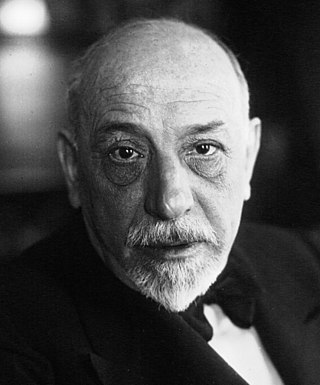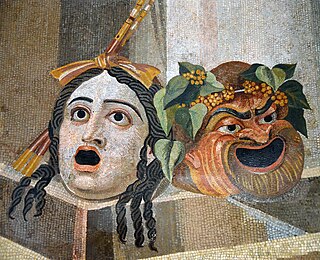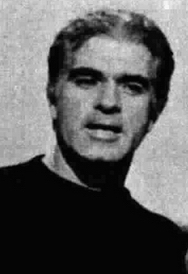Theatrical style
'Theatre of the Grotesque' is a style that is masked in ambiguity. [7] Its rejection of theatrical and social conventions, and reliance on external influences, such as audience response and reception, means that a stringent definition is difficult to develop. [1] However, being an extension of the Grotesque art movement and Crepuscular poetry, it does have some identifying features. [5]
Aesthetic conventions

'Theatre of the Grotesque' lends itself to the aesthetics of the Grotesque art movement, translating many of its images in both set and costuming. [8] One notable occurrence is the use of makeup or masks to emulate the surreal faces which litter the movement. [8] These faces, with their features being exaggerated in a way that disorients audiences/viewers, are emblematic of the Grotesque aesthetic. [8] Gargoyles were also a prominent visual feature of the first plays in this style, a direct link to the art movement. [5]
As aforementioned, 'Theatre of the Grotesque' is considered an extension of Crepuscular poetry and, thus, they have shared conventions. [5] There is a thematic consistency between the two forms as they both strive to undermine the conventional and the naturalistic in favour of a more subjective perspective on reality. [8] [6] Also, both feature unorthodox language use with the prose of the Crepuscular and the dialogue of the 'Theatre of the Grotesque' featuring the same surreal nature as their content. [8] [6]
Thematic conventions
One constant feature of 'Theatre of the Grotesque' is that it functions as a point of coalescence of life's contradictions. [8] This theatrical style incongruously mixes the beautiful with the cruel, calling into question what is considered reliable reality. [8] This joining of contradictory concepts encourages a fragmented world view which normalises the horrifying and the ludicrous in place of what is socially accepted. [5] This gives the styles a core instability which defies normative definition and reduces humanity to our savage impulses. [2]
One of the key features of 'Theatre of the Grotesque' is its comedic styling. [8] This dramatic form is often described as a tragic farce as it uses comedy, specifically physical comedy and irony, to frame its existential questioning. [5] The incongruous nature of this theatrical style is absurd and disorienting and so it often occurs that laughter seems the only rational response. [8] This humour is appealing to audiences of 'Theatre of the Grotesque' as it provides a catharsis which liberates audiences from the fear, discomfort, and bewilderment that is experienced in response to the disorienting nature of the content. [2]
Psychological conventions
A method of defining 'Theatre of the Grotesque' that, conversely to those mentioned above, does not rely on conventions and content, is that proposed by Ralf Remshardt in his book Staging the Savage God. [2] Remshardt proposes that it is the bodily and psychological response of audiences which deems 'Theatre of the Grotesque' such. [2] In this theory, 'Theatre of the Grotesque' is a product of perspective and perception, relying on the audience feeling a disconnect from reality. [2] This provides further complications in defining and identifying the style.
There are three elements or 'syndromes' which feature in Grotesque plays that are essential to harnessing this style. [5] Proposed by Stanley V Longman, these three syndromes, the 'mirror' syndrome, the 'marionette' syndrome, and the 'multiple reality' syndrome, describe the psychological conditions infused into 'Theatre of the Grotesque' plays by authors of the style. [5] The nature of these are captured in the titles of three prominent works in the style; Rosso di San Secondo's Oh Marionetes, What Pasion! (marionette syndrome), Luigi Antonelli's The Man Who Met Himself(mirror syndrome), and Luigi Pirandello's Right You Are (If You Think You Are) (multiple reality syndrome). [5]

















